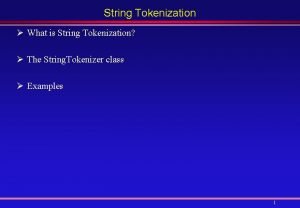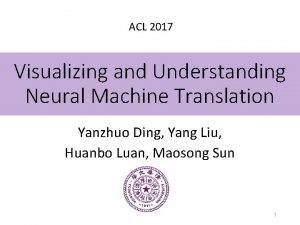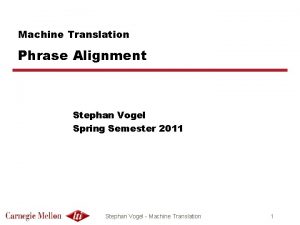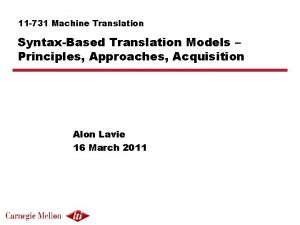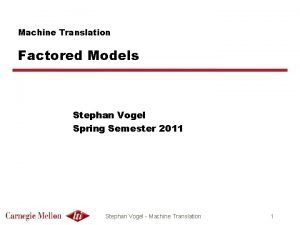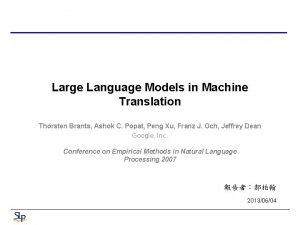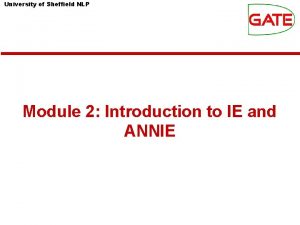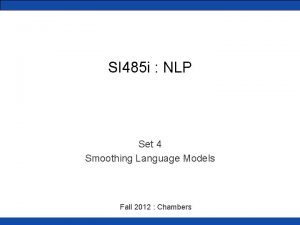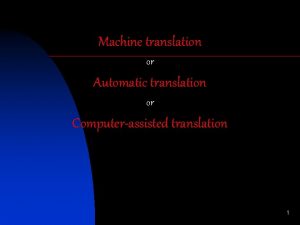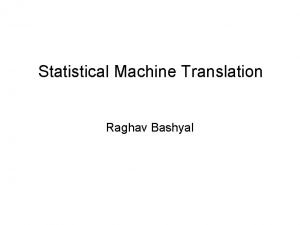NLP Machine Translation Sentence Alignment Sentence Alignment Tokenization





![Sentence Alignment [Church/Gale 1993] Sentence Alignment [Church/Gale 1993]](https://slidetodoc.com/presentation_image_h2/1827f36179a812ba5594fe2f6bfb2266/image-6.jpg)










![E-step 1: compute the expected counts E[count(t(f|e))] for all word pairs (fj, eaj) E-step E-step 1: compute the expected counts E[count(t(f|e))] for all word pairs (fj, eaj) E-step](https://slidetodoc.com/presentation_image_h2/1827f36179a812ba5594fe2f6bfb2266/image-17.jpg)

![import itertools corpus = [('green house', 'casa verde'), ('the house', 'la casa')] # Print import itertools corpus = [('green house', 'casa verde'), ('the house', 'la casa')] # Print](https://slidetodoc.com/presentation_image_h2/1827f36179a812ba5594fe2f6bfb2266/image-19.jpg)






![corpus = [('green house', 'casa verde'), ('the house', 'la casa'), ('my house', 'mi casa')] corpus = [('green house', 'casa verde'), ('the house', 'la casa'), ('my house', 'mi casa')]](https://slidetodoc.com/presentation_image_h2/1827f36179a812ba5594fe2f6bfb2266/image-26.jpg)






![[Brown et al. 1993] [Brown et al. 1993]](https://slidetodoc.com/presentation_image_h2/1827f36179a812ba5594fe2f6bfb2266/image-33.jpg)



- Slides: 36

NLP

Machine Translation Sentence Alignment

Sentence Alignment • Tokenization • Sentence alignment (1 -1, 2 -2, 2 -1 mappings) • Church and Gale 1993 – based on sentence length – similar to previous work by Brown et al. 1988


![Sentence Alignment ChurchGale 1993 Sentence Alignment [Church/Gale 1993]](https://slidetodoc.com/presentation_image_h2/1827f36179a812ba5594fe2f6bfb2266/image-6.jpg)
Sentence Alignment [Church/Gale 1993]

Machine Translation The IBM Models

Questions • If the word order is fixed – Align strings using the Levenshtein method • What about the following: – How to deal with word reorderings? – How to deal with phrases? • We need a systematic (and feasible) approach

Generative Story (almost IBM) • • I watched an interesting play play I watched an play interesting J’ ai vu une pièce de théâtre intéressante

IBM’s EM trained models (1 -5) • • • Word translation Local alignment Fertilities Class-based alignment Non-deficient algorithm (avoid overlaps, overflow)

Model 1 • Alignments – – La maison bleue The blue house Alignments: {1, 2, 3}, {1, 3, 2}, {1, 3, 3}, {1, 1, 1} A priori, all are equally likely • Conditional probabilities – P(f|A, e) = ?

Model 1 (cont’d) • Algorithm – – – Pick length of translation (uniform probability) Choose an alignment (uniform probability) Translate the foreign words (only depends on the word) That gives you P(f, A|e) We need P(f|A, e) Use EM (expectation-maximization) to find the hidden variables

Model 1 (cont’d) • Length probability • Alignment probability • Translation probability

Finding the Optimal Alignment

Training Model 1 • Goal: – Learn the translation probabilities p(f|e) • EM Algorithm – Used to estimate the translation probabilities from a training corpus – Guess p(f|e) (could be uniform) – Repeat until convergence: • E-step: compute counts • M-step: recompute p(f|e)

Example Corpus: green house casa verde Uniform translation model: the house la casa
![Estep 1 compute the expected counts Ecounttfe for all word pairs fj eaj Estep E-step 1: compute the expected counts E[count(t(f|e))] for all word pairs (fj, eaj) E-step](https://slidetodoc.com/presentation_image_h2/1827f36179a812ba5594fe2f6bfb2266/image-17.jpg)
E-step 1: compute the expected counts E[count(t(f|e))] for all word pairs (fj, eaj) E-step 1 a: compute P(a, f|e) by multiplying all t probabilities using E-step 1 b: normalize P(a, f|e) to get P(a|e, f) using E-step 1 c: compute expected fractional counts, by weighting each count by P(a|e, f)

M-step 1: Compute the MLE probability params by normalizing the tcounts to sum to 1. E-step 2 a: Recompute P(a, f|e) again by multiplying the t probabilities More iterations are needed (until convergence)
![import itertools corpus green house casa verde the house la casa Print import itertools corpus = [('green house', 'casa verde'), ('the house', 'la casa')] # Print](https://slidetodoc.com/presentation_image_h2/1827f36179a812ba5594fe2f6bfb2266/image-19.jpg)
import itertools corpus = [('green house', 'casa verde'), ('the house', 'la casa')] # Print corpus: vocab 1 = [] vocab 2 = [] print "Sentence pairs" for i in range(len(corpus)): tup = corpus[i] print i, print '%st%s' % tup vocab 1 += tup[0]. split() vocab 2 += tup[1]. split() # Print Vocabulary vocab 1 = list(set(vocab 1)) vocab 2 = list(set(vocab 2)) print "Vocabulary" print "Source Language: ", print vocab 1 print "Target Language: ", print vocab 2 print "EM initialization" prob = {} for w in vocab 1: for v in vocab 2: prob[(w, v)] = 1. / len(vocab 2) print "P(%s|%s) = %. 2 ft" % (v, w, prob[(w, v)]), print Code by Rui Zhang

def E_step(prob): print "E_step" def compute_align(a, sent_pair): print "t Alignment: ", p = 1. s = sent_pair[0]. split() t = sent_pair[1]. split() for i in range(len(a)): w = s[i] v = t[a[i]] print (w, v), p = p * prob[(w, v)] print "t p(a, f|e): %. 2 f" % p return p new_prob = {} for w in vocab 1: for v in vocab 2: new_prob[(w, v)] = 0. for i in range(len(corpus)): print "Sentence Pair", i sent_pair = corpus[i] sent_l = len(sent_pair) total_i = [] for a in itertools. permutations(range(sent_l)): total_i. append(compute_align(a, sent_pair)) #normalize #print "tp(a, f|e): ", total_i_sum = sum(total_i) total_i = [t / total_i_sum for t in total_i] print "nt Normalizing" print "t p(a|e, f): ", total_i print s = t = cnt for sent_pair[0]. split() sent_pair[1]. split() = 0 a in itertools. permutations(range(sent_l)): for j in range(len(a)): w = s[j] v = t[a[j]] new_prob[(w, v)] += total_i[cnt] cnt += 1 for w in vocab 1: total_w = 0. for v in vocab 2: total_w += new_prob[(w, v)] print "P(%s|%s) = %. 2 ft" % (v, w, new_prob[(w, v)]), print "total(%s) = %2. f" % (w, total_w) return new_prob def M_step(prob): print "M_step" for w in vocab 1: total_w = sum([prob[w, v] for v in vocab 2]) for v in vocab 2: prob[(w, v)] = prob[(w, v)] / total_w print "P(%s|%s) = %. 2 ft" % (v, w, prob[(w, v)]), print return prob for i in range(0, 10): print "step: ", i prob = E_step(prob) prob = M_step(prob)

Sentence pairs 0 green house 1 the house casa verde la casa Vocabulary Source Language: ['house', 'the', 'green'] Target Language: ['verde', 'casa', 'la'] EM initialization P(verde|house) = 0. 33 P(verde|the) = 0. 33 P(verde|green) = 0. 33 P(casa|house) = 0. 33 P(casa|the) = 0. 33 P(casa|green) = 0. 33 P(la|house) = 0. 33 P(la|the) = 0. 33 P(la|green) = 0. 33

step: 0 E_step Sentence Pair 0 Alignment: ('green', 'casa') ('house', 'verde') p(a, f|e): 0. 11 Alignment: ('green', 'verde') ('house', 'casa') p(a, f|e): 0. 11 Normalizing p(a|e, f): [0. 5, 0. 5] Sentence Pair 1 Alignment: ('the', 'la') ('house', 'casa') p(a, f|e): 0. 11 Alignment: ('the', 'casa') ('house', 'la') p(a, f|e): 0. 11 Normalizing p(a|e, f): [0. 5, 0. 5] P(verde|house) = 0. 50 P(verde|the) = 0. 00 P(verde|green) = 0. 50 P(casa|house) = 1. 00 P(casa|the) = 0. 50 P(casa|green) = 0. 50 P(la|house) = 0. 50 P(la|the) = 0. 50 P(la|green) = 0. 00 P(casa|house) = 0. 50 P(casa|the) = 0. 50 P(casa|green) = 0. 50 P(la|house) = 0. 25 P(la|the) = 0. 50 P(la|green) = 0. 00 M_step P(verde|house) = 0. 25 P(verde|the) = 0. 00 P(verde|green) = 0. 50 total(house) = 2 total(the) = 1 total(green) = 1

step: 1 E_step Sentence Pair 0 Alignment: ('green', 'casa') ('house', 'verde') p(a, f|e): 0. 12 Alignment: ('green', 'verde') ('house', 'casa') p(a, f|e): 0. 25 Normalizing p(a|e, f): [0. 33333333, 0. 66666666] Sentence Pair 1 Alignment: ('the', 'la') ('house', 'casa') p(a, f|e): 0. 25 Alignment: ('the', 'casa') ('house', 'la') p(a, f|e): 0. 12 Normalizing p(a|e, f): [0. 66666666, 0. 33333333] P(verde|house) = 0. 33 P(verde|the) = 0. 00 P(verde|green) = 0. 67 P(casa|house) = 1. 33 P(casa|the) = 0. 33 P(casa|green) = 0. 33 P(la|house) = 0. 33 P(la|the) = 0. 67 P(la|green) = 0. 00 P(casa|house) = 0. 67 P(casa|the) = 0. 33 P(casa|green) = 0. 33 P(la|house) = 0. 17 P(la|the) = 0. 67 P(la|green) = 0. 00 M_step P(verde|house) = 0. 17 P(verde|the) = 0. 00 P(verde|green) = 0. 67 total(house) = 2 total(the) = 1 total(green) = 1

step: 2 E_step Sentence Pair 0 Alignment: ('green', 'casa') ('house', 'verde') p(a, f|e): 0. 06 Alignment: ('green', 'verde') ('house', 'casa') p(a, f|e): 0. 44 Normalizing p(a|e, f): [0. 111111112, 0. 88888889] Sentence Pair 1 Alignment: ('the', 'la') ('house', 'casa') p(a, f|e): 0. 44 Alignment: ('the', 'casa') ('house', 'la') p(a, f|e): 0. 06 Normalizing p(a|e, f): [0. 88888889, 0. 111111112] P(verde|house) = 0. 11 P(verde|the) = 0. 00 P(verde|green) = 0. 89 P(casa|house) = 1. 78 P(casa|the) = 0. 11 P(casa|green) = 0. 11 P(la|house) = 0. 11 P(la|the) = 0. 89 P(la|green) = 0. 00 P(casa|house) = 0. 89 P(casa|the) = 0. 11 P(casa|green) = 0. 11 P(la|house) = 0. 06 P(la|the) = 0. 89 P(la|green) = 0. 00 M_step P(verde|house) = 0. 06 P(verde|the) = 0. 00 P(verde|green) = 0. 89 total(house) = 2 total(the) = 1 total(green) = 1

step: 3 E_step Sentence Pair 0 Alignment: ('green', 'casa') ('house', 'verde') p(a, f|e): 0. 01 Alignment: ('green', 'verde') ('house', 'casa') p(a, f|e): 0. 79 Normalizing p(a|e, f): [0. 007751937984496124, 0. 9922480620155039] Sentence Pair 1 Alignment: ('the', 'la') ('house', 'casa') p(a, f|e): 0. 79 Alignment: ('the', 'casa') ('house', 'la') p(a, f|e): 0. 01 Normalizing p(a|e, f): [0. 9922480620155039, 0. 007751937984496124] P(verde|house) = 0. 01 P(verde|the) = 0. 00 P(verde|green) = 0. 99 P(casa|house) = 1. 98 P(casa|the) = 0. 01 P(casa|green) = 0. 01 P(la|house) = 0. 01 P(la|the) = 0. 99 P(la|green) = 0. 00 P(casa|house) = 0. 99 P(casa|the) = 0. 01 P(casa|green) = 0. 01 P(la|house) = 0. 00 P(la|the) = 0. 99 P(la|green) = 0. 00 M_step P(verde|house) = 0. 00 P(verde|the) = 0. 00 P(verde|green) = 0. 99 total(house) = 2 total(the) = 1 total(green) = 1
![corpus green house casa verde the house la casa my house mi casa corpus = [('green house', 'casa verde'), ('the house', 'la casa'), ('my house', 'mi casa')]](https://slidetodoc.com/presentation_image_h2/1827f36179a812ba5594fe2f6bfb2266/image-26.jpg)
corpus = [('green house', 'casa verde'), ('the house', 'la casa'), ('my house', 'mi casa')] Sentence pairs 0 green house casa verde 1 the house la casa 2 my house mi casa Vocabulary Source Language: ['house', 'the', 'green', 'my'] Target Language: ['mi', 'verde', 'casa', 'la'] EM initialization P(mi|house) = 0. 25 P(mi|the) = 0. 25 P(mi|green) = 0. 25 P(mi|my) = 0. 25 step: P(verde|house) = 0. 25 P(verde|the) = 0. 25 P(verde|green) = 0. 25 P(verde|my) = 0. 25 P(casa|house) = 0. 25 P(casa|the) = 0. 25 P(casa|green) = 0. 25 P(casa|my) = 0. 25 0 E_step Sentence Pair 0 Alignment: ('green', 'casa') ('house', 'verde') p(a, f|e): 0. 06 Alignment: ('green', 'verde') ('house', 'casa') p(a, f|e): 0. 06 Normalizing p(a|e, f): [0. 5, 0. 5] Sentence Pair 1 Alignment: ('the', 'la') ('house', 'casa') p(a, f|e): 0. 06 Alignment: ('the', 'casa') ('house', 'la') p(a, f|e): 0. 06 Normalizing p(a|e, f): [0. 5, 0. 5] P(la|house) = 0. 25 P(la|the) = 0. 25 P(la|green) = 0. 25 P(la|my) = 0. 25

Sentence Pair 2 Alignment: ('my', 'mi') ('house', 'casa') p(a, f|e): 0. 06 Alignment: ('my', 'casa') ('house', 'mi') p(a, f|e): 0. 06 Normalizing p(a|e, f): [0. 5, 0. 5] P(mi|house) = 0. 50 P(mi|the) = 0. 00 P(mi|green) = 0. 00 P(mi|my) = 0. 50 P(verde|house) = 0. 50 P(verde|the) = 0. 00 P(verde|green) = 0. 50 P(verde|my) = 0. 00 P(casa|house) = 1. 50 P(casa|the) = 0. 50 P(casa|green) = 0. 50 P(casa|my) = 0. 50 P(la|house) = 0. 50 P(la|the) = 0. 50 P(la|green) = 0. 00 P(la|my) = 0. 00 P(verde|house) = 0. 17 P(verde|the) = 0. 00 P(verde|green) = 0. 50 P(verde|my) = 0. 00 P(casa|house) = 0. 50 P(casa|the) = 0. 50 P(casa|green) = 0. 50 P(casa|my) = 0. 50 P(la|house) = 0. 17 P(la|the) = 0. 50 P(la|green) = 0. 00 P(la|my) = 0. 00 P(verde|house) = 0. 00 P(verde|the) = 0. 00 P(verde|green) = 1. 00 P(verde|my) = 0. 00 P(casa|house) = 1. 00 P(casa|the) = 0. 00 P(casa|green) = 0. 00 P(casa|my) = 0. 00 P(la|house) = 0. 00 P(la|the) = 1. 00 P(la|green) = 0. 00 P(la|my) = 0. 00 M_step P(mi|house) = 0. 17 P(mi|the) = 0. 00 P(mi|green) = 0. 00 P(mi|my) = 0. 50. . . step: . . . 3 M_step P(mi|house) = 0. 00 P(mi|the) = 0. 00 P(mi|green) = 0. 00 P(mi|my) = 1. 00 total(house) = 3 total(the) = 1 total(green) = 1 total(my) = 1

corpus = [('green house', 'casa verde'), ('the house', 'la casa'), ('my house', 'mi casa'), ('my houses', 'mis casas ')] Sentence pairs 0 green house casa verde 1 the house la casa 2 my house mi casa 3 my houses mis casas Vocabulary Source Language: ['house', 'the', 'green', 'my', 'houses'] Target Language: ['casa', 'la', 'mi', 'verde', 'casas', 'mis'] EM initialization P(casa|house) = 0. 17 P(casa|the) = 0. 17 P(casa|green) = 0. 17 P(casa|my) = 0. 17 P(casa|houses) = 0. 17 step: P(la|house) = 0. 17 P(la|the) = 0. 17 P(la|green) = 0. 17 P(la|my) = 0. 17 P(la|houses) = 0. 17 P(mi|house) = 0. 17 P(mi|the) = 0. 17 P(mi|green) = 0. 17 P(mi|my) = 0. 17 P(mi|houses) = 0. 17 0 E_step Sentence Pair 0 Alignment: ('green', 'casa') ('house', 'verde') p(a, f|e): 0. 03 Alignment: ('green', 'verde') ('house', 'casa') p(a, f|e): 0. 03 Normalizing p(a|e, f): [0. 5, 0. 5] Sentence Pair 1 Alignment: ('the', 'la') ('house', 'casa') p(a, f|e): 0. 03 Alignment: ('the', 'casa') ('house', 'la') p(a, f|e): 0. 03 Normalizing p(a|e, f): [0. 5, 0. 5] P(verde|house) = 0. 17 P(casas|house) = 0. 17 P(mis|house) =0. 17 P(verde|the) = 0. 17 P(casas|the) = 0. 17 P(mis|the) =0. 17 P(verde|green) = 0. 17 P(casas|green) = 0. 17 P(mis|green) =0. 17 P(verde|my) = 0. 17 P(casas|my) = 0. 17 P(mis|my) = 0. 17 P(verde|houses) = 0. 17 P(casas|houses) = 0. 17 P(mis|houses)= 0. 17

Sentence Pair 2 Alignment: ('my', 'mi') ('house', 'casa') p(a, f|e): 0. 03 Alignment: ('my', 'casa') ('house', 'mi') p(a, f|e): 0. 03 Normalizing p(a|e, f): [0. 5, 0. 5] Sentence Pair 3 Alignment: ('my', 'mis') ('houses', 'casas') p(a, f|e): 0. 03 Alignment: ('my', 'casas') ('houses', 'mis') p(a, f|e): 0. 03 Normalizing p(a|e, f): [0. 5, 0. 5] P(casa|house) = 1. 50 P(casa|the) = 0. 50 P(casa|green) = 0. 50 P(casa|my) = 0. 50 P(casa|houses) = 0. 00 P(la|house) = 0. 50 P(la|the) = 0. 50 P(la|green) = 0. 00 P(la|my) = 0. 00 P(la|houses) = 0. 00 P(mi|house) = 0. 50 P(mi|the) = 0. 00 P(mi|green) = 0. 00 P(mi|my ) = 0. 50 P(mi|houses) = 0. 00 P(verde|house) = 0. 50 P(verde|the) = 0. 00 P(verde|green) = 0. 50 P(verde|my ) = 0. 00 P(verde|houses) = 0. 00 P(casas|house) = 0. 00 P(casas|the) = 0. 00 P(casas|green) = 0. 00 P(casas|my) = 0. 50 P(casas|houses) = 0. 50 P(mis|house) = 0. 00 P(mis|the) = 0. 00 P(mis|green) = 0. 00 P(mis|my) = 0. 50 P(mis|houses) = 0. 50 P(la|house) = 0. 17 P(la|the) = 0. 50 P(la|green) = 0. 00 P(la|my) = 0. 00 P(la|houses) = 0. 00 P(mi|house) = 0. 17 P(mi|the) = 0. 00 P(mi|green) = 0. 00 P(mi|my ) = 0. 25 P(mi|houses) = 0. 00 P(verde|house) = 0. 17 P(verde|the) = 0. 00 P(verde|green) = 0. 50 P(verde|my ) = 0. 00 P(verde|houses) = 0. 00 P(casas|house) = 0. 00 P(casas|the) = 0. 00 P(casas|green) = 0. 00 P(casas|my) = 0. 25 P(casas|houses) = 0. 50 P(mis|house) = 0. 00 P(mis|the) = 0. 00 P(mis|green) = 0. 00 P(mis|my) = 0. 25 P(mis|houses) = 0. 50 M_step P(casa|house) = 0. 50 P(casa|the) = 0. 50 P(casa|green) = 0. 50 P(casa|my) = 0. 25 P(casa|houses) = 0. 00 total(house) = 3 total(the) = 1 total(green) = 1 total(my) = 2 total(houses) = 1

step 3: M_step P(casa|house) = 1. 00 P(casa|the) = 0. 00 P(casa|green) = 0. 00 P(casa|my) = 0. 00 P(casa|houses) = 0. 00 P(la|house) = 0. 00 P(la|the) = 1. 00 P(la|green) = 0. 00 P(la|my) = 0. 00 P(la|houses) = 0. 00 P(mi|house) = 0. 00 P(mi|the) = 0. 00 P(mi|green) = 0. 00 P(mi|my) = 0. 50 P(mi|houses) = 0. 00 P(verde|house) = 0. 00 P(casas|house) = 0. 00 P(mis|house) = 0. 00 P(verde|the) = 0. 00 P(casas|the) = 0. 00 P(mis|the) = 0. 00 P(verde|green) = 1. 00 P(casas|green) = 0. 00 P(mis|green) = 0. 00 P(verde|my) = 0. 00 P(casas|my) = 0. 25 P(mis|my) = 0. 25 P(verde|houses) = 0. 00 P(casas|houses) = 0. 50 P(mis|houses) = 0. 50

Model 2 • Distortion parameters d(i|j, l, m) – i and j are words in the two sentences – l and m are the lengths of these sentences • Example – d(“boy”|”garçon”, 5, 6) • The distortion parameters are also learned by EM

Model 3 • Fertility f( i|e) f 0 is an extra parameter that defines 0 • Examples – – NOUN – VERB program = programme play = pièce de théâtre place = mettre en place f(1|program) 1 f(3|play_N) 1 f(3|place_V) 1
![Brown et al 1993 [Brown et al. 1993]](https://slidetodoc.com/presentation_image_h2/1827f36179a812ba5594fe2f6bfb2266/image-33.jpg)
[Brown et al. 1993]

IBM Models 4 and 5 • Model 4 – Deals with relative reordering • Model 5 – Fixes problems in models 1 -4 that allow multiple words to appear in the same position

References • http: //www. isi. edu/natural-language/mt/wkbk. rtf (an awesome tutorial by Kevin Knight) • http: //www. statmt. org/ (a comprehensive site, including references to the old IBM papers, pointers to Moses, etc. )

NLP
 Tokenization in information retrieval
Tokenization in information retrieval What is tokenization
What is tokenization String tokenization
String tokenization Global alignment
Global alignment Difference between local and global alignment
Difference between local and global alignment Sequence alignment
Sequence alignment Global alignment vs local alignment
Global alignment vs local alignment Global vs local alignment
Global vs local alignment Semantic translation is
Semantic translation is Cisco voice translation rule
Cisco voice translation rule Transformations of linear functions
Transformations of linear functions 10 noun phrases
10 noun phrases Interactive machine translation
Interactive machine translation Lms machine translation
Lms machine translation Visualizing and understanding neural machine translation
Visualizing and understanding neural machine translation Machine translation
Machine translation Machine translation
Machine translation Machine translation
Machine translation Machine translation
Machine translation Meteor vs bleu
Meteor vs bleu Lms machine translation
Lms machine translation Machine translation in natural language processing
Machine translation in natural language processing John hutchins machine translation
John hutchins machine translation Machine translation presentation
Machine translation presentation Large language models in machine translation
Large language models in machine translation Finite state machine vending machine example
Finite state machine vending machine example Mealy moore
Mealy moore Mealy to moore conversion
Mealy to moore conversion Differentiate between simple machine and compound machine
Differentiate between simple machine and compound machine Example of irrelevant sentences
Example of irrelevant sentences Short incomplete sentences
Short incomplete sentences Sheffield nlp
Sheffield nlp Annie nlp
Annie nlp Gate nlp
Gate nlp Nlp midterm exam
Nlp midterm exam Statistical natural language processing
Statistical natural language processing Language
Language


